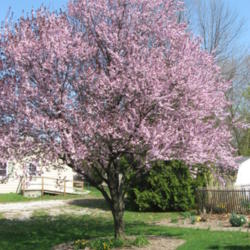| We recently planted a purple leaf plum tree in our front yard (east facing) at our first house. It's surrounded by rocks. It seems to be doing fine, has some new growth, but not much. It's on a 14 min./day drip system. However, we learned after planting it that they like high humidity. Is this true, and if so, what would you suggest? We don't want to move it nor can we put grass down around it. We thought of planting some sort of plants around the base of it - would that help at all, and if so, what kind of plants would you recommend for this? Any info. regarding purple leaf plum trees would be greatly appreciated, as this is the first tree we have ever planted. |

Drip emitters come in different "sizes" based on how much water they put out, such as 1, 2 or 4 gallons. Running drip emitters daily for short periods is seldom effective because the water doesn't soak deep enough to moisten the root ball. For example, an emitter that puts out one gallon per hour would only put a quart of water on the ground in 15 minutes. A good way to visualize this is to imagine filling a Big Gulp cup and pouring it on the ground. Does that seem like sufficient water for a tree? Nope! For mature trees, each irrigation should soak 3 feet deep; for newly planted trees, about 2 to 2.5, depending on the size/depth of the rootball when it was planted. Also, water should be applied evenly all around the tree's circumference at the dripline (the outer edge of the canopy where rain would "drip" off the tree). This is where its feeder roots are growing and spreading, and actively absorbing water. Applying water with one emitter right at the base of a trunk doesn't do anything as the tree grows. So, move those emitters outwards as the tree expands. You may need to do this twice a year, or perhaps annually, depending on growth rate. Use a soil probe (any long, pointed piece of metal, such as a long BBQ skewer, or a sharpened piece of rebar) to poke into the soil and check how far water has penetrated. The probe moves easily through moist soil, but stops when it hits hard dry soil. There are numerous variables involved for watering schedules, such as type of soil, how fast or slow it drains, sun and wind exposure at your site, temperature, age and condition of the plants and much more. Use the information above to determine how moist the soil is before automatically applying more water. It's essential that you allow your drip system to run long enough for water to penetrate the appropriate depth. Depending on the size emitters, soil type, etc. this might take several or many hours. You can change the emitters to put out more gallons per hour, or add more emitters. As the tree grows, you'll likely have to do this. Here's why watering deeply is essential, in addition to just ensuring the roots get wet. Desert soil and water both contain salts, which can accumulate in the root zone over time. Salts dissolve in the water, and buildup where the water stops penetrating. Short periods of watering cause salts to accumulate in the top layers of soil, roots absorb it, and eventually damage or kill your plant. Salt burn shows up as yellowing and then browning along leaf margins. Deep watering or leaching, prevents this by flushing the salts past the root zone. As a tree grows, its new roots tips, where nutrients are being absorbed, spread out laterally. Expand your watering zone out PAST the tree's canopy edge, or dripline, as it grows. As the tree grows, continue expanding that water zone. If you have an irrigation system, you need to move the emitters out. Or drag a hose out further. With any plant in the desert, your goal is to water slowly, deeply and as infrequently as possible for that plant's needs. Here are some watering guidelines for establishing desert-adapted plants in summer from Desert Landscaping for Beginners, published by Arizona Master Gardener Press. Weeks Since Planting 1-2, water every 1-2 days; Weeks 3-4, water every 3-4 days; weeks 5-6, water every 4-6 days; weeks 7-8, water every 7 days. Gradually extend the watering as plants establish. Note these are guidelines, which will vary depending on your soil type, microclimate, etc. and they apply to desert-adapted plants. Your plum tree is not entirely desert-adapted, but not entirely high-water-use either, so you may need to monitor it until you understand your microclimate (soil, weather, exposure, etc.) Desert adapted trees that are already established take watering every 7-21 days in summer; non-native, high water use trees every 7-14 days. In winter, water less frequently. I suggest that you get a soil probe, and after your drip runs, use the probe to see how far water penetrates. Repeat the drip in 15 or 30 minute increments until you determine that the water soaks through the root depth. Then you'll know how long to program the timer for. Good luck! |